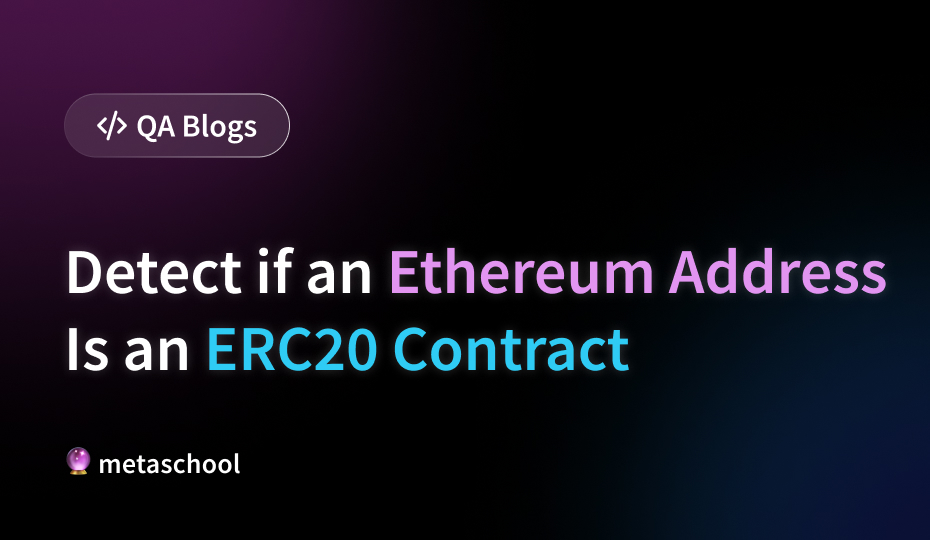Table of Contents
Detecting whether an Ethereum address belongs to an ERC20 token contract requires a bit of investigation, as there’s no single foolproof method. Here’s a breakdown of some techniques you can employ:
Understanding ERC20 Standards
ERC20 (ERC stands for Ethereum Request for Comment) is a widely used standard that defines a set of functions and events for token contracts on the Ethereum blockchain. These functions and events allow for functionalities like transferring tokens, checking balances, and approving token spending. By checking for the presence of these specific functionalities associated with the ERC20 standard, you can increase your confidence in identifying an ERC20 token contract.
Method 1: Checking for Code Existence
- Blockchain Explorer: Your first step can involve using a blockchain explorer like Etherscan (https://etherscan.io/) or Bloxy (https://bloxd.io/). These platforms allow you to search for Ethereum addresses. Once you have the target address, you can check if the explorer categorizes it as a “Token Contract.” While this is a good starting point, it relies on the explorer’s analysis, which might not always be definitive.
- Code Verification (Optional): Some blockchain explorers allow you to view the contract code itself. If you’re comfortable with Solidity (the programming language used for smart contracts), you can skim the code to see if it implements ERC20 standard functions like
transfer,balanceOf, andtotalSupply. However, this method requires some technical knowledge and can be time-consuming for multiple addresses.
🔥 Check this course out: Create Your Own Ethereum Token in Just 30 Mins
Method 2: Using On-chain Calls (More Reliable)
A more reliable approach involves interacting with the contract address directly on the blockchain. This can be done through tools or libraries that allow you to call specific functions on the target contract. Here’s the process:
- ERC20 Function Calls: The ERC20 standard defines functions like
balanceOf(address owner)(to check an address’s balance) andtotalSupply()(to check the total token supply). You can use a tool or library to call these functions on the target address. - Evaluating Return Values: If the function calls succeed and return valid values (e.g., a non-zero balance or a total token supply), it’s a strong indication that you’re dealing with an ERC20 token contract. However, there’s a small caveat:
- False Positives: In rare cases, a contract might be designed to mimic the behavior of these functions even though it’s not a true ERC20 compliant contract. This is why relying solely on function calls might not be foolproof.
Combining Techniques for Better Accuracy
For the most accurate results, it’s recommended to combine these methods:
- Start with a blockchain explorer: Check if the address is categorized as a token contract.
- Use on-chain calls: Call ERC20 standard functions like
balanceOfandtotalSupplyto verify their presence and valid return values.
🔥 Check this course out: Build a One Piece Personality dApp With Solidity
Limitations and Cautions
- Not Guaranteed: Even with these methods, there’s still a small possibility of encountering a non-standard contract that mimics ERC20 behavior.
- Security: If you’re interacting with the blockchain directly through tools or libraries, make sure they are from reputable sources to avoid potential security risks.
- Alternatives: For some use cases, there might be alternative ways to identify token contracts. For instance, some projects might have official registries or APIs that can confirm the token’s existence and legitimacy.
Remember: Detecting ERC20 token contracts can be a multi-step process. By understanding the ERC20 standard and combining different techniques, you can increase your confidence in identifying them on the Ethereum blockchain. However, it’s always wise to exercise caution and use reliable tools and resources when interacting with the blockchain.
Conclusion: Unveiling the ERC20 Mystery
The world of Ethereum tokens can be vast and sometimes shrouded in a bit of technical mystery. But by wielding the knowledge of ERC20 standards and the tools available, you can become a blockchain detective and effectively identify these token contracts. Remember, the key is a multi-pronged approach:
- Leverage blockchain explorers for initial categorization.
- Utilize on-chain calls with ERC20 functions for a more robust confirmation.
- Be aware of potential limitations and prioritize security when interacting with the blockchain.
As you explore further, stay curious and keep learning about the ever-evolving realm of blockchain technologies. With this knowledge in your arsenal, you’ll be well-equipped to navigate the exciting landscape of ERC20 tokens and beyond!
Follow us on –
🔮Twitter – https://twitter.com/0xmetaschool
🔗LinkedIn – https://www.linkedin.com/company/0xmetaschool/
